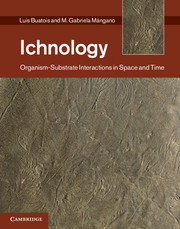Book contents
- Frontmatter
- Contents
- Acknowledgments
- Introduction
- Part I Conceptual tools and methods
- Part II Spatial trends
- Part III A matter of time
- 12 Trace fossils in sequence stratigraphy
- 13 Trace fossils in biostratigraphy
- 14 Trace fossils in evolutionary paleoecology
- 15 Ichnology in paleoanthropology and archaeology
- References
- Index
13 - Trace fossils in biostratigraphy
from Part III - A matter of time
Published online by Cambridge University Press: 25 October 2011
- Frontmatter
- Contents
- Acknowledgments
- Introduction
- Part I Conceptual tools and methods
- Part II Spatial trends
- Part III A matter of time
- 12 Trace fossils in sequence stratigraphy
- 13 Trace fossils in biostratigraphy
- 14 Trace fossils in evolutionary paleoecology
- 15 Ichnology in paleoanthropology and archaeology
- References
- Index
Summary
Invertebrate trace fossils can be used for the stratigraphic correlation of otherwise nonfossiliferous clastic sequences, provided that they share particular “fingerprints” and thus reflect behavioral diversification within taxonomically coherent groups of (commonly unknown) tracemakers.
Dolf Seilacher Trace Fossil Analysis (2007)In contrast to body fossils, trace fossils are often characterized by long temporal ranges and narrow facies ranges (see Section 1.2.8). As a consequence, trace fossils are highly useful in paleoenvironmental analysis and less so in biostratigraphic studies. Although most ichnogenera display long temporal ranges, it is also true that some biogenic structures can preserve specific fingerprints of their producers. If the producers record significant evolution, then the trace fossils may also yield biostratigraphic implications (Seilacher, 2007b). There are some ichnofossils that reflect particular kinds of animals in which body morphology and behavior underwent closely related evolutionary transformations through time (Seilacher, 2000). The more complex (in terms of fine morphological detail) a structure is, the more direct its biological relationship, distinctive its behavioral program, and hence, larger its biostratigraphic significance. Historically invertebrate trace fossils have been applied in biostratigraphy in two main areas: the positioning of the Proterozoic–Cambrian boundary (e.g. Seilacher, 1956; Banks, 1970; Alpert, 1977; Crimes et al., 1977; Narbonne et al., 1987; Crimes, 1992, 1994; Jensen, 2003) and the establishment of relative ages in lower Paleozoic clastic successions based on Cruziana and related trilobite trace fossils (e.g. Seilacher, 1970, 1992a, 1994; Crimes, 1975). In recent years, attempts have been made to incorporate other ichnotaxa, such as Arthrophycus and related trace fossils (e.g. Seilacher, 2000; Mángano et al., 2005b). In the field of vertebrate ichnology, tetrapod trackways have a long tradition in biostratigraphy, particularly in upper Paleozoic–Mesozoic strata (e.g. Haubold and Katsung, 1978; Lucas, 2007). In this chapter we will address the utility of both invertebrate and vertebrate trace fossils in biostratigraphy.
- Type
- Chapter
- Information
- IchnologyOrganism-Substrate Interactions in Space and Time, pp. 252 - 264Publisher: Cambridge University PressPrint publication year: 2011



